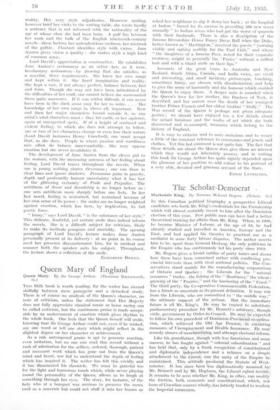Queen Mary of England
Tiiis little book is worth reading, for the writer has steered skilfully between, mere panegyric and a detached study. There is of course no analysis of the Queen's character, no note of criticism, unless the statement that Her Majesty does not fully appreciate classical music or horse racing can be called criticism, but the continuous praise is made accept- able by an undercurrent of emotion which gives rhythm to the whole book. One feels that the Queen herself will smile, knowing that Sir George Arthur could not, even if he wished, say one word or tell one story which might reflect in the slightest degree on her character or achievement.
As a rule untempered praise is apt to generate reaction, even irritation, but no one can read this record without a rush of admiration for the selfless, ordered, thorough, patient and incessant work which has gone out from the Queen's mind and heart, nor fail to understand the depth of feeling which has inspired it. The writer has felt this vividly and it has illuminated his chronicle. We must be grateful too for the light and humorous touch which, while never playing round the personality of the Queen, allows' us to laugh at something through her eyes. The story, for instance, of the lady who at a banquet was anxious to preserve the menu card as a souvenir but could not stuff it into her bosom so'
asked her neighbour to slip it down her back ; or the hospital at Indore " famed for its success-in providing 500 new noses annually " to Indian wives who had got the worst of quarrels with their husbands. There is also a 'description of the famous Devonshire House Fancy Dress Ball when the Duke, better known as " Hartington," received the guests " yawning visibly and sighing audibly for the Turf Club," and where " the daughters of a famous Peer, noted for their exquisite neatness, sought to personify the ` Rules ' without .a ruffled hair and with a bland smile on their•liPs."
Accounts of the great tours to Australia and New Zealand, South Africa, Canada, and India twice, are vivid and interesting, and „small incidents picturesque, touching, sometimes 'funny, are chosen with discrimination; and help to give the sense of humanity and the humour. Which enabled the Queen to enjoy them. A deeper note is sounded when the Queen's love for her mother, the Duchess of Teck, is described, and her sorrow over the death of her youngest brother Prince Francis and her eldest brother " Dolly." The War record of the Queen is perhaps not given adequate justice ; we should have enjoyed too a few details about the actual furniture and the works of art which she both discovered and re-arranged, treasures which belong to the history of England.
It is easy to criticize and to note omissions and to weary a little of the constant reference to ceremonies and jewels and clothes. Yet this last comment is not quite fair. The fact that these details are about the Queen does give them an interest which they would not inherently possess, and in writing this book Sir George Arthur has quite rightly depended upon the glamour of her position to add colour to his portrait of a very able, devoted and gracious servant of the State.
EDITH LYTTELTON.










































 Previous page
Previous page